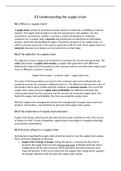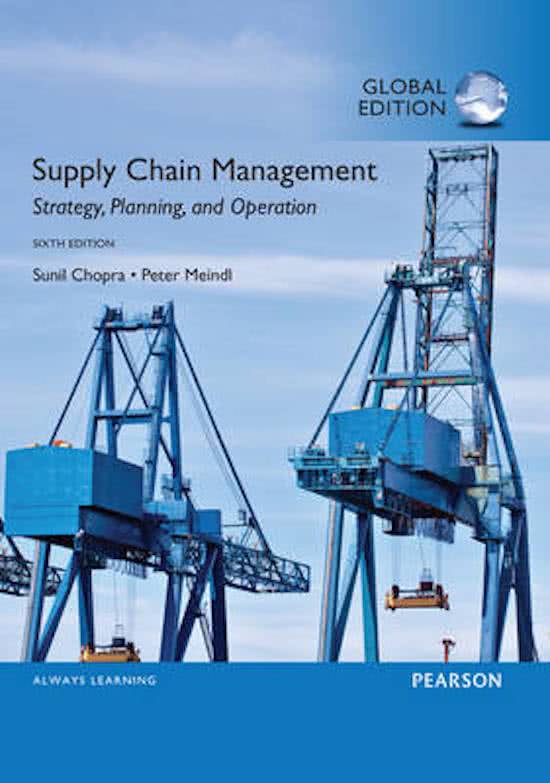C1 Understanding the supply chain
§1.1 What is a supply chain?
A supply chain consists of all parties involved, directly or indirectly, in fulfilling a customer
request. The supply chain includes not only the manufacturer and suppliers, but also
transporters, warehouses, retailers, customers, product development, marketing,
customers etc. A supply chain is dynamic and involves the constant flow of information,
product, and funds among different stages. The primary purpose of any supply chain is to
satisfy customer needs and, in the process, generate profit for itself. Most supply chains are
networks, because more players can be involved at a certain stage.
§1.2 The objective of a supply chain
The objective of every supply chain should be to maximize the overall value generated. The
value (also known as supply chain surplus) a supply chain generates is the difference
between the value of the final product to the customer and the costs the entire supply chain
incurs in filling the customer’s request.
Supply chain surplus = customer value – supply chain cost
The value of the final product can vary for every customer and can be estimated by the
maximum amount the customer is willing to pay for it. The difference between the value of
the product and its price remains with the customer as consumer surplus. The rest of the
supply chain surplus becomes supply chain profitability, the difference between the
revenue generated from the customer and the overall cost across the supply chain. The
higher the supply chain profitability, the more successful the supply chain.
Effective supply chain management involves the management of supply chain assets and
product-, information-, and fund flows to grow the total supply chain surplus.
§1.3 The importance of supply chain decisions
Supply chain design, planning and operation decisions play a significant role in the success
or failure of a firm. To stay competitive, supply chains must adapt to changing technology
and customer expectations.
§1.4 Decision phases in a supply chain
Each decision regarding the supply chain should be made to raise the supply chain surplus.
There are three categories of decisions:
1. Supply chain strategy or design: during this phase, a company decides how to
structure the supply chain over the next several years. It decides what the chain’s
configuration will be, how resources will be allocated, and what processes each
stage will perform. A firm must ensure that the supply chain configuration supports
its strategic objectives and increases the supply chain surplus.
, 2. Supply chain planning: the time frame for these decisions is a quarter to a year. This
configuration establishes constraints within which planning must be done.
3. Supply chain operation: the time horizon here is weekly or daily. Companies make
decisions regarding individual customer orders.
§1.5 Process views of a supply chain
There are 2 ways to view the processes performed in a supply chain:
1. Cycle view: the processes in a supply chain are divided into a series of cycles, each
performed at the interface between two successive stages of the supply chain.
2. Push/pull view: the processes in a supply chain are divided into 2 categories,
depending on whether they are executed in response to a customer order or in
anticipation of customer orders. Pull processes are initiated by a customer order,
whereas push processes are initiated and performed in anticipation of customer
orders.
Cycle view
All supply chain processes can be broken down into 4 process cycles (Left figure). Each cycle
occurs at the interface between 2 successive stages of the supply chain. Each cycle consists
of 6 subprocesses (Right figure). A cycle view of the supply chain clearly defines the
processes involved and the owners of each process. This view is useful when considering
operational decisions because it specifies the roles and responsibilities of each member of
the supply chain and the desired outcome for each process.
Push/Pull view
With pull (or reactive) processes, execution is initiated in response to a customer order.
With push (speculative) processes, execution is initiated in anticipation of customer orders
based on a forecast.
The push/pull boundary in a supply chain separates push processes from pull processes. A
push/pull view of the supply chain categorizes processes based on whether they are
initiated in response to a customer order (pull) or in anticipation of a customer order (push).
This view is useful when considering strategic decisions relating to supply chain design. The
, goal is to identify an appropriate push/pull boundary such that the supply chain can match
supply and demand effectively.
All supply chain processes can be classified into the following 3 macro processes:
1. Customer Relationship Management (CRM): all processes at the interface between
the firm and its customers.
2. Internal Supply Chain Management (ISCM): all processes that are internal to the
firm.
3. Supplier Relationship Management (SRM): all processes at the interface between
the firm and its suppliers.
C2 Supply chain performance
§2.1 Competitive and supply chain strategies
A company’s competitive strategy defines, relative to its competitors, the set of customer
needs that it seeks to satisfy through its products and services. The competitive strategy
targets one or more customer segments and aims to provide products and services that
satisfy these customers’ needs.
A company’s value chain is shown below:
All these functions play a role to execute a company’s competitive strategy and each must
develop its own strategy. Strategy refers to what each process or function will try to do to
do particularly well.
§2.2 Achieving strategic fit
Strategic fit requires that both the competitive and supply chain strategies of a company
have aligned goals. It refers to consistency between the customer priorities that the
competitive strategy hopes to satisfy and the supply chain capabilities that the supply chain
strategy aims to build. For a company to achieve strategic fit, it must accomplish the
following:
1. The competitive strategy and all functional strategies must fit together to form a
coordinated overall strategy.
2. The different functions in a company must appropriately structure their processes
and resources to be able to execute these strategies successfully.





